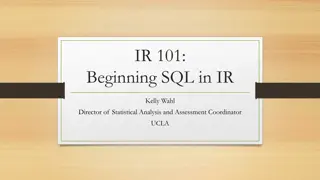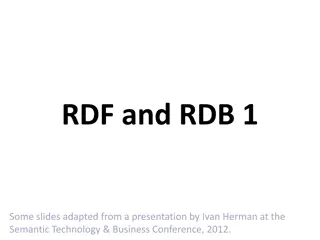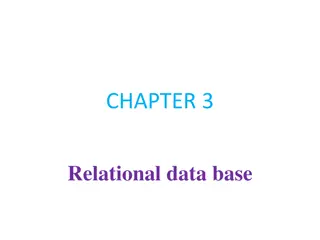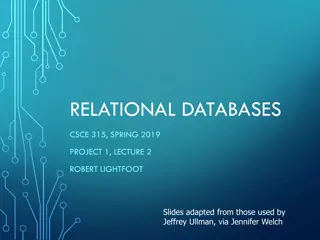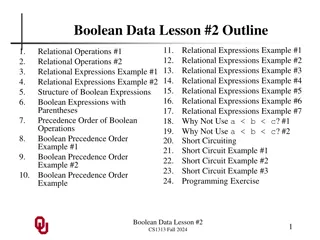Understanding Stored and Inherited Relations in Relational Databases
Explore the concept of Stored and Inherited Relations (SIR) in relational databases, as discussed by Witold Litwin at Dauphine University. Discover how a typical scheme of a stored relation defines a natural SIR, leading to more efficient query formulations and less procedural querying processes. Learn about the importance of SIR-enabled databases and the role they play in modern database technology.
Download Presentation

Please find below an Image/Link to download the presentation.
The content on the website is provided AS IS for your information and personal use only. It may not be sold, licensed, or shared on other websites without obtaining consent from the author. Download presentation by click this link. If you encounter any issues during the download, it is possible that the publisher has removed the file from their server.
E N D
Presentation Transcript
Natural Stored and Inherited Relations Witold Litwin Dauphine University Witold.litwin@dauphine.psl.eu Presentation at EUSPN/ICTH 2021, Leuven, Belgium.
Whats Up ? Presumably, everyone in this room is familiar with some SQL DBS A typical scheme of a stored relation (SR), say R, with foreign keys is not only what you were all told it is I.e., defines SR R only It defines in fact a natural Stored and Inherited Relation (SIR) R.
Whats Up ? A typical query formulating as select- project-join one to R, with joins being equijoins over foreign and referenced keys, formulates as select-project one only to SIR R The logical navigation free (LNF) query to R in popular terms
Is It Important? LNF queries are substantially less procedural in practice There is no any additional data definition work for the DBA An old dream for the relational DBs becomes true
Whats Up We recall what SIRs are in general We define natural SIRs We show how the scheme of a typical SR R with foreign keys implicitly defines also natural SIR R On a SIR-enabled (relational) DBS 5
Whats Up We outline how to make a popular DBS SIR-enabled We show that this could be simple We postulate that every major DBS should become SIR-enabled better sooner than later . 6
Present Foundations of RDBs Relational database (DB) technology is the core for any modern databases: Client, Web, Cloud, Big Data You name it There are millions of relational DBs around 7
Stored and Inherited Relation (SIR) A (relational) DB consists at present from: Some stored relations (SRs) with stored attributes (SAs) only, also called base tables One cannot calculate SA values from the DB scheme Optionally, - also from views With inherited attributes (IAs) only IA-values calculate from the view scheme Basically, calculate only 8
Stored and Inherited Relation (SIR) A SIR R is an SR R enlarged with some IAs Every SR R tuple becomes sub-tuple of exactly one SIR R tuple SIR R does not have any other tuples IAs calculate as if they were in view R defining logically the same relation as SIR R Termed C-view R IAs in a SIR form an Inheritance Expression (IE) SR R may be, by default, referred to as R_ in SIR R As well as in C-view R scheme [1] Litwin, W. SQL for Stored and Inherited Relations. 21stIntl. Conf. on Enterprise Information Systems, (ICEIS 2019), http://www.iceis.org/?y=2019 , 12p. 9
Motivating Example : Codds biblical S-P DB S-P1 Scheme Table S Table P Table SP S# Char, SNAME Char, STATUS Char, CITY Char; P# Char, PNAME Char, COLOR Char, WEIGHT Char, S# Char, P# Char, QTY Int, 10
Motivating Example : Codds biblical S-P DB S-P1 Scheme Table S Table P Table SP S# Char, SNAME Char, STATUS Char, CITY Char; P# Char, PNAME Char, COLOR Char, WEIGHT Char, S# Char, P# Char, QTY Int, SP.S# and SP.P# are foreign keys Althougt none is a key of SP S.S# and P.P# are referenced keys These are primary keys 11
Motivating Example : Foreign Keys Consider e.g., the query Q: select every SNAME, QTY, PNAME where QTY < 300 SQL formulations of Q make sense only because of the foreign keys. 12
Example Suppose now S-P.SP SQL scheme as follows: Create Table SP (S# Char 5, P# Char 5, QTY INT, Primary Key (S#, P#)); One may enlarge it to SIR SP with IE as follows: Create Table SP (S# Char 5 {SNAME, STATUS, S.CITY} P# Char 5 {PNAME, COLOR, WEIGHT, P.CITY} QTY INT {From SP_ Left Join S On (SP_.S# = S.S#) LEFT JOIN P On (SP_.P# = P.P#)} Primary Key (S#, P#)); SP_ designates by default S-P.SP above { } are brackets around parts of the IE Make SIRs simpler to implement IE is red and Italic for didactic purpose only 13
Example Create Table SP (S# Char 5 {SNAME, STATUS, S.CITY} P# Char 5 {PNAME, COLOR, WEIGHT, P.CITY} QTY INT {From SP_ Left Join S On (SP_.S# = S.S#) LEFT JOIN P On (SP_.P# = P.P#)} Primary Key (S#, P#)); SIR SP is mathematically the same as C-view SP: Create View SP AS Select SP_.S#, SNAME, STATUS, S.CITY, SP_.P#, PNAME, COLOR, WEIGHT, P.CITY, QTY From SP_ Left Join S On (SP_.S# = S.S#) LEFT JOIN P On SP_.P# = P.P#; o SP_ designates S-P.SP renamed so by default o From now on, S-P1 designates S-P with SIR SP 14
S-P1 DB with SIR SP IA names and value are Italic S-P2 Content Table S S# S1 S2 S3 S4 S5 Table P P# PNAME COLOR WEIGHT CITY P1 Nut Red P2 Bolt Green P3 Screw Blue P4 Screw Red P5 Cam Blue P6 Cog Red SNAME Smith Jones Blake Clark Adams STATUS 20 10 30 20 30 CITY London Paris Paris London Athens 12 17 Paris 17 Oslo 14 London 12 Paris 19 London Lon<don Table SP S# S1 S1 S1 S1 S1 S1 S2 S2 S3 S4 S4 S4 SNAMES Smith Smith Smith Smith Smith Smith Jones Jones 10 Blake Clark Clark Clark STATUS 20 20 20 20 20 20 10 S.CITY London London London London London London Paris Paris Paris London London P# P1 P2 P3 P4 P5 P6 P1 P2 P2 P2 P4 P5 PNAME COLOR WEIGHT P.CITY Nut Red 12 Bolt Green 17 Screw Blue 17 Screw Red 14 Cam Blue 12 Cog Red Nut Red 12 Bolt Green 17 Bolt Green 17 Bolt Green 17 Screw Red 14 Cam Blue 12 QTY 300 London Paris 200 Oslo London 200 Paris 100 London 100 London Paris Paris 200 Paris London Paris 400 19 300 400 30 20 20 20 London 200 300 400 15
S-P DB with view SP SP_ View SP S# S1 S1 S1 S1 S1 S1 S2 S2 S3 S4 S4 S4 SNAMES Smith Smith 20 Smith Smith Smith 20 Smith 20 Jones Jones 10 Paris Blake 30 Clark 20 Clark 20 Clark 20 London STATUS 20 S.CITY London London London London London London Paris P# P1 P2 P3 P4 P5 P6 P1 P2 P2 P2 P4 P5 PNAME COLOR WEIGHT P.CITY Nut Red 12 Bolt Green 17 Screw Blue 17 Screw Red 14 Cam Blue 12 Cog Red 19 Nut Red 12 Bolt Green 17 Bolt Green 17 Bolt Green 17 Screw Red 14 Cam Blue 12 Paris 400 QTY 300 London Paris 200 Oslo London 200 Paris 100 London 100 London 300 Paris 400 Paris 200 Paris 200 London 300 20 20 400 10 Paris London London 16
Why View SP for S-P ? Our query Q to S-P with base tables only, formulates as SQL select-project-join query: Select SNAME, QTY, PNAME From SP Left Join S On (SP.S# = S.S#) Left Join P On (SP.P# = P.P#) Where QTY < 300; In red there is the logical navigation (LN) over S, SP and P Left joins are necessary since, basically, there is no referential integrity in S-P 17
Why View SP for S-P ? With view SP used instead of S-P.SP, Q formulates as the LNF SQL select-project: Select SNAME, QTY, PNAME Where QTY < 300 From SP; Substantially less procedural formulation Fewer mandatory characters to type-in 18
Why SIR SP Instead of view SP ? Given S-P1.SP instead of view SP in S-P, Q would be: Select SNAME, QTY, PNAME Where QTY < 300 From SP; Same thus except that QTY is an SA and SP is a SIR Who cares ? 19
Why SIR SP instead of View SP ? IE in SIR SP is less procedural than view SP 112 mandatory characters instead of 157 Procedurality (so time) gain of almost 30 % (157 112) / 157 Non-procedurality was a driving force for Database Science o For the relational model / Codasyl model in particular For entire Computer Science, in fact 20
Can We Do Better ? How far can we reduce the procedurality of IE for SP scheme ? Hurray! Typically to ZERO Create Table SP for SR SP may indeed suffice as an implicit Create Table SP for SIR SP By inferring from it the explicit Create Table SP for SIR SP With every IA and From clause 21
How ? Every foreign key implicitly inherits as an IA every non-key attribute of the referenced relation With the same proper name and same value for the same key value In the nutshell, this usually defines for an SR R with foreign keys its natural SIR R Our SP is the natural SP (for SR SP and SP_) 22
How ? Our implicit natural SIR SP scheme is the one of S-P.SP: Create Table SP (S# Char 5, P# Char 5, QTY INT, Primary Key (S#, P#)); Our explicit natural SIR SP scheme is the example one: Create Table SP (S# Char 5 {SNAME, STATUS, S.CITY} P# Char 5 {PNAME, COLOR, WEIGHT, P.CITY} QTY INT {From SP_ Left Join S On (SP_.S# = S.S#) LEFT JOIN P On (SP_.P# = P.P#)} Primary Key (S#, P#)); One can infer IAs from SYSTABLES of any popular DBS See (easy) rules in the paper 23
SIR-enabled DBS SIR-layer manages all SIRs Internally calls existing (kernel) SQL DBS (not SIR-enabled) SP defined as presently, canonically becomes internally Base table SP_ (S#, P#, QTY) C-view SP formed from { .} SIR-layer canonically directs every (select) query to C-view SP Discussed LNF-queries are OK SIR-enabled DBS SIR-layer Kernel SQL DBS 24
Conclusion Better late than never , every DBS should become SIR-enabled Able to manage natural SIRs LNF queries should become a standard Queries with LN: an exception For advanced clients Or in bad dream from the past There are other benefits from SIRs we did not speak about See the referenced papers 25
Conclusion Likely, millions of DBAs, clients developers should benefit from SIR-enabled relational DBSs 26
Thanks For Your Attention Witold LITWIN Witold.litwin@dauphine.psl.eu 27






